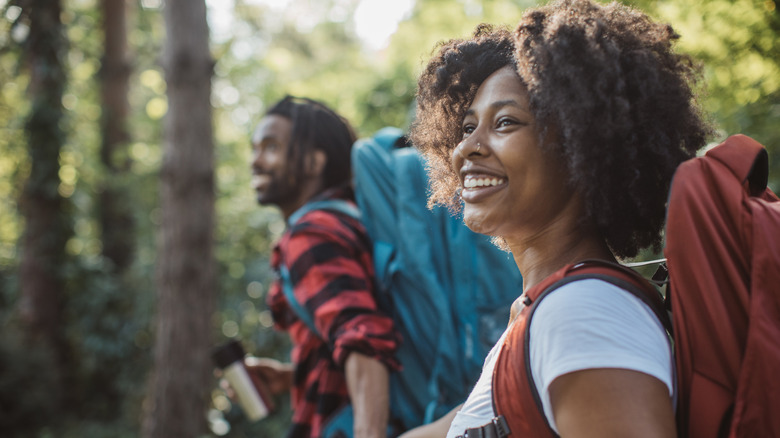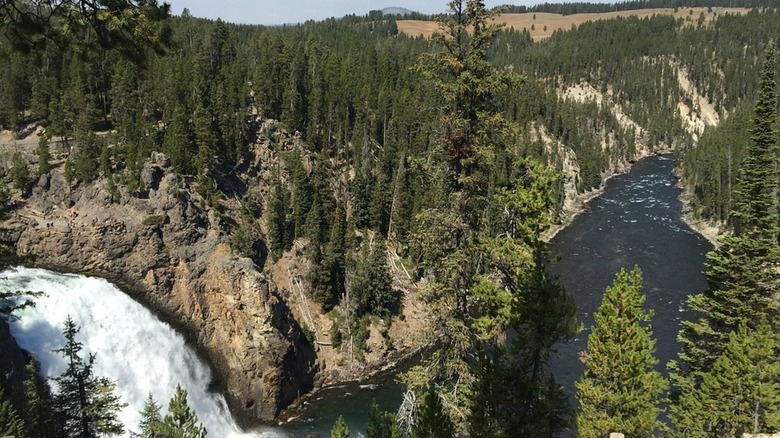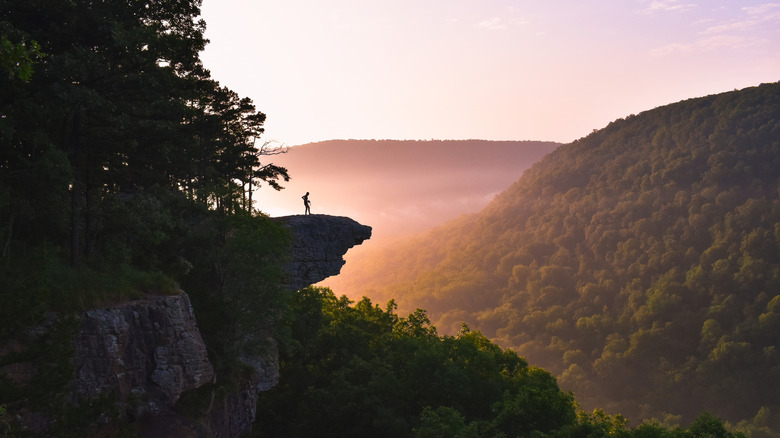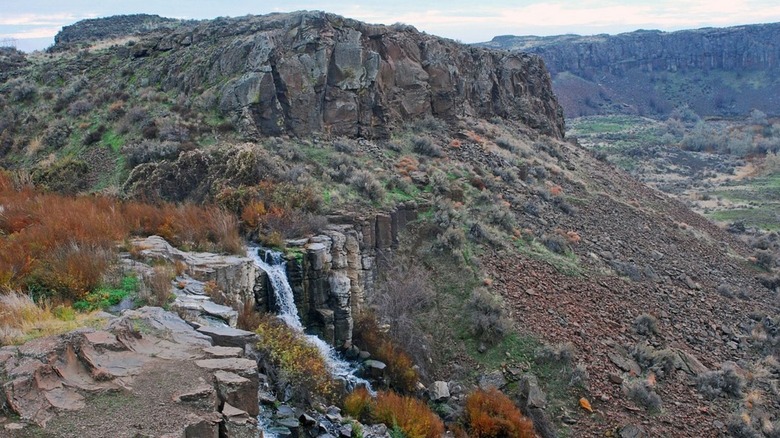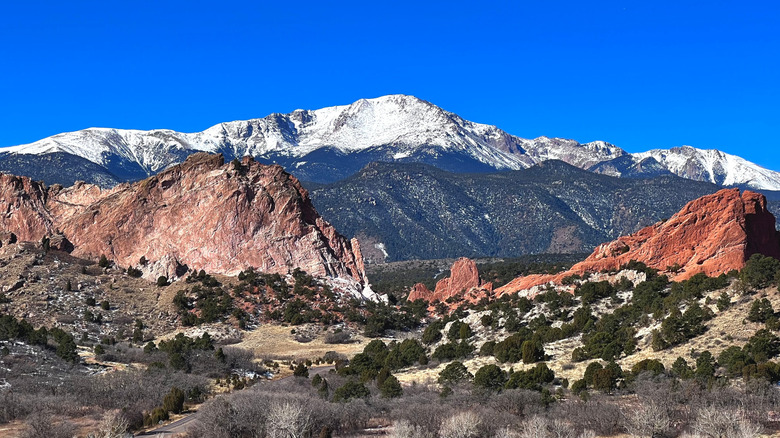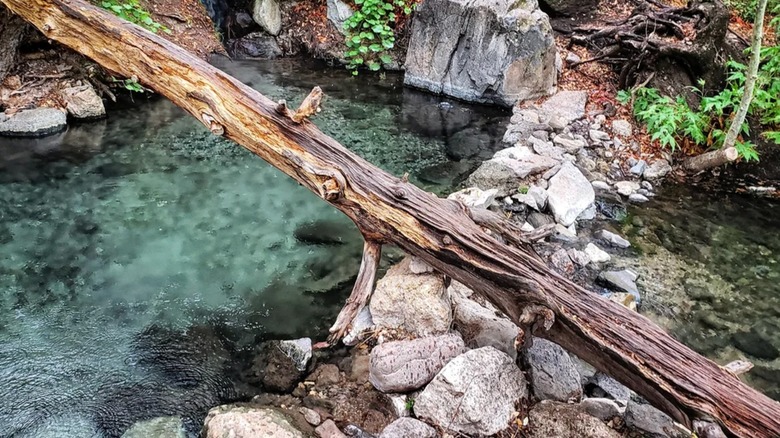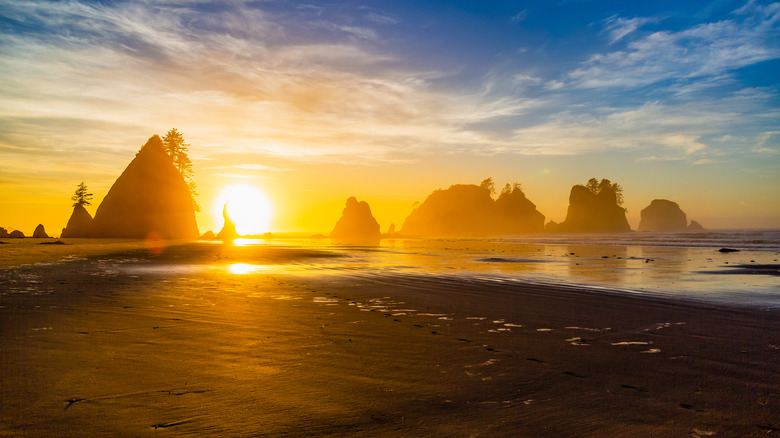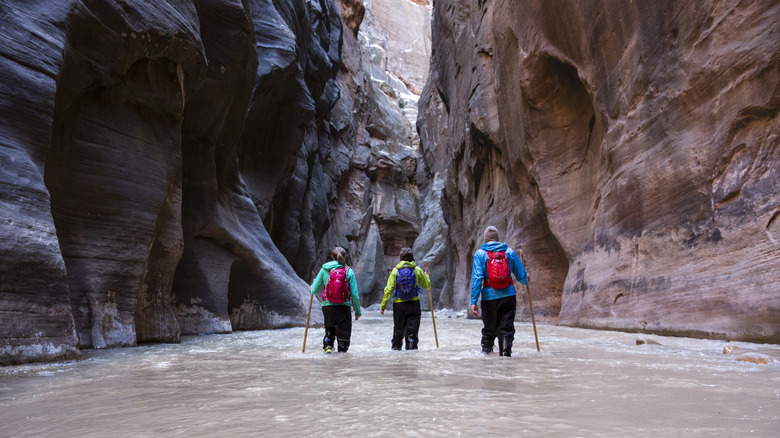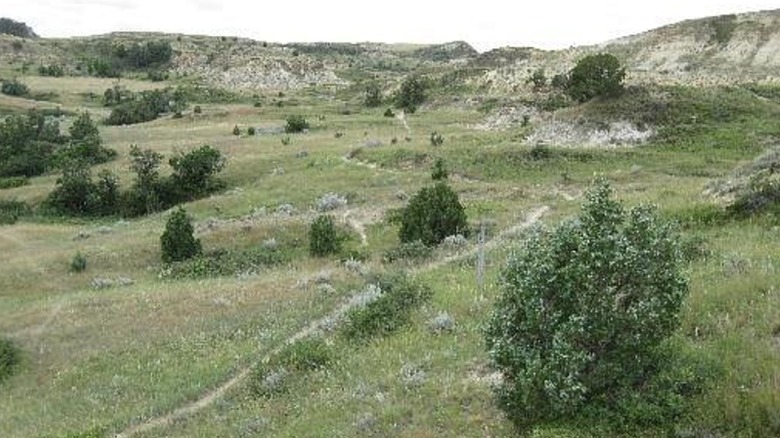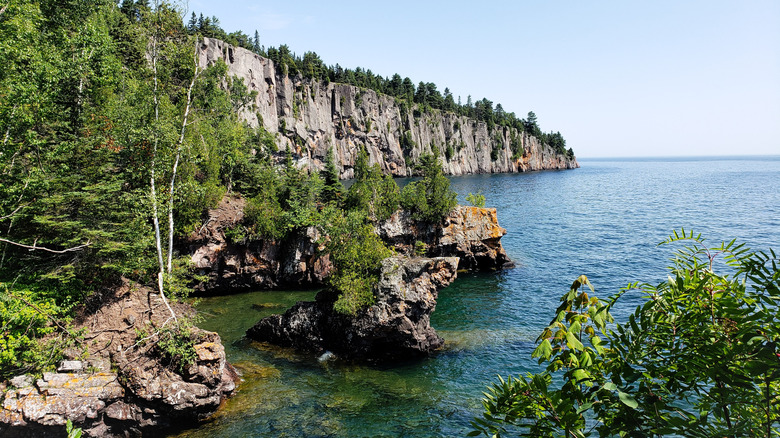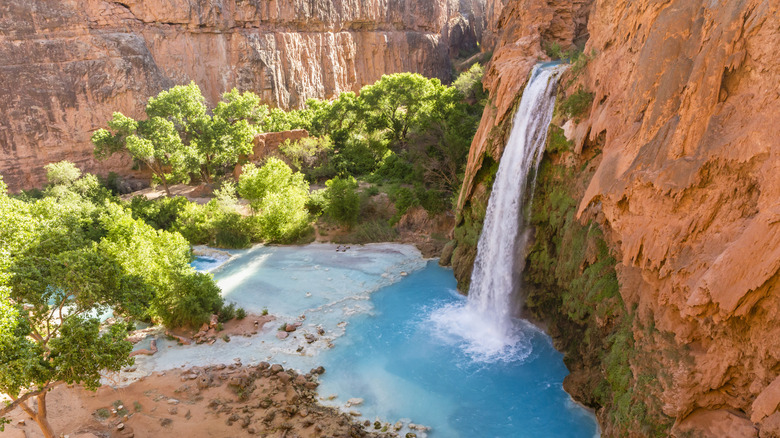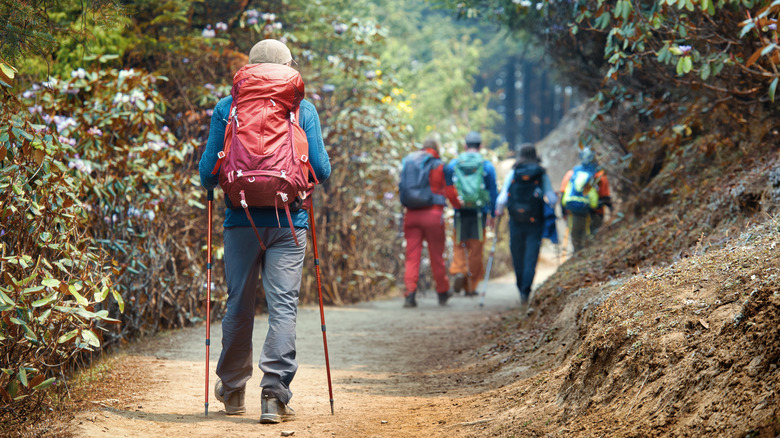These Stunning Mountain Destinations Are Great For Beginner Backpacking Trips, According To Research
Heading out for an adventure beyond the comfort of tame indoor spaces is often a priority for eager explorers. Whether you're meandering around a park or trail for the day or plotting a longer camping trip that will span a weekend or more, there's no denying the power that these kinds of adventures hold over us. It's well-known that time spent outdoors is a potent mood improver. But these kinds of journeys also help introduce an important exercise element that nourishes the body and improves focus. Hiking, camping, and more offer a total body rejuvenation that's hard to beat. It's for this reason that backpacking has become so popular in the modern era of extended screentime and indoor work environments. This activity tends to come about as a multi-day camping adventure (but always heed this crucial advice to make your backpacking adventures enjoyable).
Backpacking becomes much harder in certain locations and terrains. Mountainous areas are one of those potentially difficult settings, but they make for some of the most visually stunning locales. As Explore researched this article, we discovered that heightened elevation gain is a real problem beginners have to deal with. As such, we selected beginner trails and campground amenities on flatter grounds — a feature that isn't typical of the mountain hiking experience. But that doesn't mean it's impossible to find. These destinations deliver the mountain air alongside beginner-friendly hiking conditions that make them accessible to those just starting in this fascinating hobby.
Canyon Rim South Trail in Yellowstone National Park
Yellowstone National Park is a brilliant example of America's outdoor heritage. The landscape was the first to be designated as a national park in the United States (gaining this vaunted title in 1872) and perhaps the first in the world. There's a depth of beauty and history found here that's hard to fully flesh out. Suffice it to say, Yellowstone is a national treasure that merges Native history, the stark beauty of the northwestern landscape, and the very foundations of the American experience.
Fortunately for avid outdoor explorers, Yellowstone isn't as off-limits to novice hikers and backpackers as the mountainous terrain might initially suggest. The Canyon Rim South Trail is a great example of the park's beginner-friendly offerings. This is a 6.9-mile out-and-back hike that gains 860 feet of elevation along the way. Yellowstone is one of the national parks that requires a permit for camping, fishing, and other activities, so organizing this permission is essential before you venture off on the trail. However, once you've accomplished the preliminary legwork, the trail will deliver some truly spectacular views.
Along the hike, you'll traverse the side of the canyon that drops down toward the Yellowstone River. Passing two sets of falls, hikers will follow the trail to Point Sublime, a place with a name that hits the nail on the head. There's parking near Artist Point, midway along the journey, so backpackers have the option to bail if met with trouble. There are numerous designated campgrounds along the canyon, and with your backcountry permit in tow, pitching a tent at a backcountry site is also an option.
The Ozark Trail in Missouri's iconic mountains
The Ozark Trail is made up of 14 segments that combine to deliver a 390-mile trail that thru hikers traverse with great enthusiasm. The full trail runs from Onondaga Cave State Park to the western end of Mark Twain State Forest. Much like a thru-hike of the Appalachian Trail, this is a big achievement on the bucket lists of many experienced hikers and backpackers. Fortunately for those with far less time out in the wilderness under their belts, each of these segments is navigable on its own, and beginners can often chop the hikes down even further when required.
A decent choice for those seeking a leisurely adventure might be the Between the Rivers section of the trail. This is a 28-mile hike that's admittedly a bit longer than the typical beginner option. The adventure also features a total elevation gain of 3,638 feet, but that's spread across a gradual incline that spans the length of the trek. The hike connects the Eleven Point River and the Current River, and will see you gradually climb through white and scarlet oak forests in a powerfully tranquil environment. Perhaps more importantly for novice backpackers, the whole region is underpinned by a rural but sprawling local community. There are numerous options available for camping and restocking of supplies along and between the trail segments.
The Ancient Lakes Trail near Seattle
Seattle is a wonderful metropolitan area that warrants immense exploration. There are plenty of excellent things to see and do in Seattle on a budget, but one big feature of any trip to the Pacific Northwest's most prominent cityscape involves getting out of the town center. Instead of spending all your time wandering around the city streets, many visitors look to get out to Washington's abundant natural environs. Seattle is a fantastic base of operations for the hungry explorer, with Olympic National Park just a stone's throw away.
Another excellent means of escaping into nature can be found along the Ancient Lakes Trail. Also close to Seattle (roughly three hours away), this outstanding hiking adventure features a 4-mile out-and-back loop that takes explorers into a stunning mountainous valley. It's also just an hour away from Palouse Falls. The hike features very little elevation gain (unless you choose to extend the voyage and climb up the mountains surrounding the valley). This makes it a great choice for those who are concerned about burning out midway through an exhausting climb. Most intriguing of all, the scenic landscape surrounded by breathtaking mountainous rises only gets better when the sun begins to set. Those camping in the valley on a clear night get to witness a brilliant starry show that only amplifies the memories made on the trip.
Numerous trails through Colorado's Garden of the Gods
Garden of the Gods is a fabulous haven for all things idyllic, mountainous adventure. The Colorado staple has been a natural treasure. Charles Elliott Perkins gifted the landscape to Colorado Springs in 1909, mandating that it remain free and open to the public. The area is bristling with amazing sights and activities, but its 21 miles of hiking trails are really what backpackers and explorers are coming for.
Numerous options include beginner-friendly trails, but others have been rated advanced, making this a hotspot for hikers of all skill levels. Some of the easier options include the Perkins Central Garden Trail and the Siamese Twins Trail. They are 1.5- and 1-mile looping trails, respectively, that offer breathtaking views with very little elevation gain (30 feet and 150 feet, respectively). The twins trail provides a spectacular view of Pikes Peak through a window created by the "twins," giving this route its name.
Another quality choice is the Gateway and Central Gardens Trails. This is a 2.5-mile adventure that begins in the facility's overflow parking lot. The voyage carries you along paved trails to meet up with the Central Garden Trail that brings explorers along a loop near the base of the Garden's tallest rock structure. After you've completed your day of hiking, there are numerous camping options at the Garden and in its surrounding areas.
Jordan Hot Springs, Gila National Forest
The Jordan Hot Springs Trail feeds hearty adventurers to the elements. The trail features an early uphill segment that brings you up above the stunning canyon landscape below in the starkly beautiful New Mexico desert. The total elevation gain is roughly 700 feet over the span of the 7-mile, out-and-back trek to the springs. It's the only way to reach the hot springs, so the hike out into the Gila wilderness is sure to exude tranquility and offer a break away from reliance on technology that many backpackers seek. The trail is well-maintained, making it relatively simple to traverse. However, its churning direction brings hikers through roughly 15 river crossings, adding something new to the mix that many other hikes lack.
Getting wet is unavoidable here, but the sacrifice is worth it. Bringing along water shoes and carrying some extra socks will be key parts of the packing process when gathering your hiking gear. The trek isn't strictly easy, but the rewards are out of this world. A soak in the hot springs will melt away any discomfort that might have followed you along the trail, and permit-free camping areas can be found around the springs, too. This means that backpackers can trek into the forest and stay overnight before heading back to civilization.
Point of Arches, Olympic National Park
With an elevation gain of around 200 feet across an 8.8-mile out-and-back trail that benefits from a dedicated creek water source at the campground, the Point of Arches hike is tailor-made for beginners. The voyage begins within the Makah Reservation and takes adventurers along Washington's untamed coastline. The hike begins in forestlands and ends with a few miles traversed on a sandy beach within Olympic National Park. Because of the aquatic elements of this voyage, it's important not to forget a few backpacking essentials like the microfiber towel.
The early segment of the forest trail features a boardwalk, but for those who aren't prepared to get extremely muddy, it's best to wait to tackle the hike until the rainy season has passed (the fall is best). However, it's worth remembering that this region is well-known for its gray skies and drizzly rain, so be prepared for wet conditions regardless of the season (and consider skipping the umbrella to fit in when in nearby Seattle!). Among the most important points of your plan, it's crucial to check the tide chart before setting off on an adventure here. The best journey along this sandy shoreline is experienced during low tide. When the waters flow out, you'll get to wander through innumerable tidepools that amplify the experience and set the whole scene in a far more magical light. On a more practical note, the hike is far more challenging when traversing the rugged terrain due to the high tide.
The Narrows in Zion National Park
This is a hike that can be accomplished in a single day. For explorers short on time and experienced enough to traverse the entire circuit quickly, that's perhaps the best approach. But The Narrows are best experienced at a leisurely pace, and for that, you'll want to gather up your backpacking equipment and make a weekend out of the adventure. In total, backpackers are looking at a 16-mile hike that features off-trail segments and wet elements. That makes it a moderately challenging voyage, especially for those without experience in these regards.
However, Zion National Park is one of the most visited in America, and it benefits from plenty of park infrastructure and is frequently hiked by people of all experience levels. This means you're likely to be among plenty of other eager travelers as you make your way through the trails, lending a natural level of support to those who might require a helping hand or a bit of encouragement along the way.
The Narrows, in particular, features as one of the park's most popular areas and represents one of the most prominent reasons visitors flock to it. Preparing for an overnight hike requires a wilderness permit if the Virgin River is flowing at a high rate, but renting gear to keep you dry is possible. There are also 12 campsites along the canyon over a 2-mile stretch. As a result, it's important to plan and understand the conditions of the trail and competition for camping spots before venturing into the Utah wilderness.
Maah Daah Hey Trail in North Dakota
A beautiful hiking trail in the United States' least visited state, the Maah Daah Hey Trail is criminally overlooked by backpackers seeking a memorable trip and a breathtaking view. The trail itself covers a total distance of 120 miles and is frequented by hikers and mountain bikers alike. You might even come across a rugged adventurer on horseback while navigating this gem of outdoor tranquility. Fortunately for the typical hiker, there's no need to commit to the entire length of the voyage. The trail features eight discrete segments as well as six individual access points to make planning a bite-sized journey along its meandering mountainous terrain achievable.
The southernmost portion of the trail arcs its way around Billings Slope and points directly toward White Butte, the highest point in North Dakota. Across its north-south route, you'll encounter 10 campgrounds, many with running water and RV hookup options that can support a more involved mobile camping setup. The trail also runs through Theodore Roosevelt National Park. The scenery offers some of the best vistas in the North Dakota badlands. There are river crossings along certain points of the trail, delivering a bit more adventure for those seeking a challenge.
The Superior Hiking Trail along Minnesota's coastline
Like the U.S.'s other amazing thru-hike opportunities, the Superior Hiking Trail is a collection of backpacking segments that many avid explorers dream of tackling in full. The whole thing traverses the Minnesota coastline of Lake Superior and runs for a total distance of 310 miles. A thru-hike will not be in the cards for a novice backpacker. However, the trail offers plenty of easily accessible segments that make exploring a portion of this spectacular landscape possible for hikers of all skill levels.
There are numerous larger segments, but each one also features shorter, 10-mile increments that can deliver immense natural beauty over a 2-day hike or long weekend adventure. The plethora of choices available here makes the trail an ideal option for newer backpackers seeking a wonderful experience without having to commit to a lengthy loop or exhausting climb. Along the way, you'll find 94 backcountry campsites and numerous trailheads that start every few miles along the 7 primary sections. Most beneficial to newer backpackers is the marking system.
The entirety of the SHT length is well marked with blue blazes found at even intervals throughout the expanse. This makes it somewhat difficult to get lost as you navigate your chosen segment. Sections along the Caribou Falls to Lutsen segment (including the 2.5-mile Oberg Mountain Loop just south of Lutsen) and from there to Grand Marais offer some of the most beautiful scenery and plenty of camping options. The final stretch, from Grand Marais to 270 Degree Overlook, is perhaps the easiest overall.
Havasu Falls in the Grand Canyon (and Havasupai Reservation)
The falls are part of Havasu Creek, and the trail that brings backpackers to this spectacular aquatic feature is packed full of breathtaking views from start (within the Havasupai Reservation) to finish. This trail is a bit more demanding than most featured on this list, and you'll need a permit from the Havasupai tribal government. But beginners with a bit of athleticism and determination will find the challenge rewarding and well within their wheelhouse. The journey is roughly 25 miles, round-trip, making it one of the longer voyages highlighted here. Moreover, the adventure may require two nights of camping rather than just a single overnight stay. This means you'll need to consider packing a bit more gear, adding to the weight you'll heave along the trail. There are numerous established campgrounds along the well-marked trail, as well as amenities to help support your adventure, like clean water sources.
On your way into the canyon to see the falls, you'll descend around 2,500 feet, making the 'in' voyage far easier than the return, which requires an elevation climb of that same height. The return can be somewhat strenuous, but taking it slow and shedding some of your rations naturally over the course of your early adventure helps make it more manageable. As well, the ease of the entry phase means that hikers will have more energy to enjoy the sights and sounds of the journey early on. This makes the trip a thoroughly rewarding one that mixes excellent sightseeing with a late-game challenge that will only feed your hunger for more backpacking adventures in the near future.
Methodology
Stunning views were something of a non-negotiable when researching this article. No one wants to go camping or hiking in an area that doesn't exhibit at least some natural beauty. The awe of a backdrop that rises in all directions plays a pivotal role in the experience itself, even in dense forested areas that don't benefit from expansive views like those on the mountainside.
In addition to our hiking experience, we consulted sites such as Wildland Trekking for beginner-friendly backpacking routes. We focused on those that feature low total mileage, well-maintained or, at least, well-marked trails, and a lack of extreme elevation gain. Naturally, those early in their backpacking journey will want to not only seek out shorter trails, but also options that don't require numerous days of roughing it.
Diving right in can be a bit overwhelming, so overnight trips or those that can be extended to two or three nights at a maximum are the best choices for newer backpackers. Each of the trails highlighted here fits within these guidelines fairly well. None require the strenuous act of climbing huge elevation gains, and each one is (or can be) fairly short, with a one-night stay typically a reasonable option.
